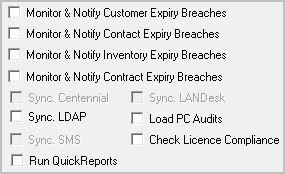To audit an estate there are various options.
- Add code to your login scripts to execute supaudit.exe in the shared directory. This will create an audit file and write it to the auditor directory for loading into HotH. If a blind audit is required (one in which there is no visible display to the end user) then the supaudith.exe file should be used.
- Visit each PC, navigate to the auditor directory on the HotH Share and fire off the supaudit.exe file manually.
- Visit each PC with a memory stick containing the supaudit.exe file and the supaudit.ini file. Navigate to the memory stick and fire off the supaudit.exe file. The resulting audit file will be written back to the memory stick and can be transferred back to the appropriate directory later for loading into HotH.
- If the psexec file is installed in the auditor directory the option to Discover Computers in my Domain is active and HotH will attempt to discover and audit any PC’s on the network. Key to this feature working is the existance of a network logon that has access to every PC.
- A batch file can be written that calls supaudit.exe from the share and starts the audit. This can be loaded on all machines and scheduled using the Windows scheduler.
Once one/many PCs have been audited the files can be loaded manually from the Audit Screen, or this task can be automated using the HotH Workflow Engine – also known as the Escalator. There is a tick option on the configuration screen of the Workflow Engine to enable this:

Still haven’t found what you’re looking for? Contact documentation@houseonthehill.com



